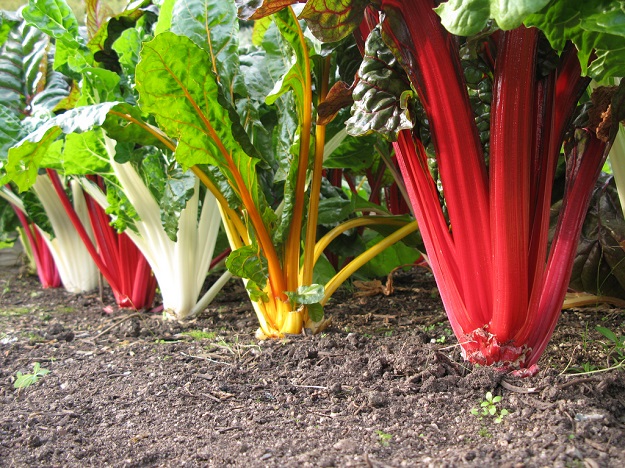
After months of care, even the most experienced gardener can hesitate before bringing the fruits (or vegetables) of their labor into the kitchen. Yet, the most satisfying food experiences come from plants grown just a few feet away from the kitchen door, and eating fresh produce also allows for maximum nutritional benefits. Happily, it’s also fast food without the waste or the drive. Sometimes a bountiful harvest can be an embarrassment of riches; however, help is here. It’s all in understanding the food that you’ve grown and the fun in experimenting with its uses.
Swiss Chard
Chard is a nutritional powerhouse, bursting with Vitamins A and C, as well as Potassium and fiber. It’s a versatile green, and caught at the right time, it can all be used. Tender young leaves go in salads or in sandwiches for a break from lettuce, but older leaves and stems require some preparation.
A handy rule though, is to use chard similarly to spinach; added to lasagna and sauce for pasta or in eggs for a weekend brunch. An efficient way to cut the leaves is to notch the stem out at the bottom, in an inverted V shape, stack the leaves, roll them, and slice them into ribbons. This decreases the cooking time as well as the preparation time. It’s important not to cook chard in aluminum pots as oxalic acid present in the plant will discolor pans of that type.
The green is handled differently based on geography; it’s popular in the Mediterranean and a simple salad can be made by boiling the leaves for just three minutes, then draining. Toss with a chopped clove of garlic, lemon juice and good olive oil and you have a fast veggie side dish for a weeknight supper. Chard shrinks like spinach does, so a big handful becomes a manageable serving size for one person.
European cooks value chard stems as well, which can be used until they are too tough and woody. A delicious gratin can be made with chard stems, cleaned, peeled and boiled until tender. Drain, then place in a baking pan with a generous drizzle of extra virgin olive oil or butter. Top with fresh grated cheese like Parmesan or Pecorino Romano and bake at 400 until the cheese is golden, about 20 minutes.
American cooks use the leaves of chard more frequently and they can be treated as other greens. A traditional Southern recipe for greens calls for about five pounds of leaves and starts with bacon or smoked meat, sautéed in a pot, with chopped onion and chili pepper if desired. Once the onions have turned transparent, add broth and the leaves. The pot simmers for about an hour and makes a hearty dish to serve with cornbread. The greens can be made meatless with the substitution of Liquid Smoke and the use of vegetarian broth. Chard, including the chopped stems, makes a great addition to many soups, including minestrone or chicken noodle, and is a great way to bump up the nutritional content.
Rolls like stuffed cabbage can use both the leaves and the stems, start by separating the stems from the leaves with the inverted V cut. The leaves need only be dipped for a few minutes into boiling water, until tender. The stems can be sauteed in olive oil with leftover cooked rice, onion, and bacon or golden raisins. Once the stems are tender, fill each leaf with two tablespoons or so of the filling, wrap them and steam in a covered pan with a little water for about ten minutes. A couple of these little packets are satisfying and travel well for lunch the next day.
Amy Ambrosius is a writer and budding gardener living deep in the heart of Texas with her family.
Related Articles & Free Email Newsletter
Curious About CBD? Here’s What it Can and Cannot Do for You
How to Use Food Scraps to Grow More Food
Micro Greens Taste Great and Can Be a Small Greenhouse Growers Profit Center



Comment here